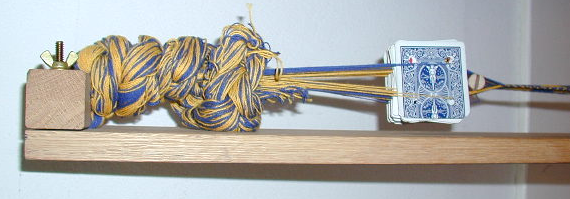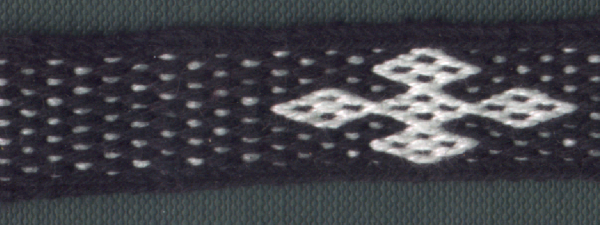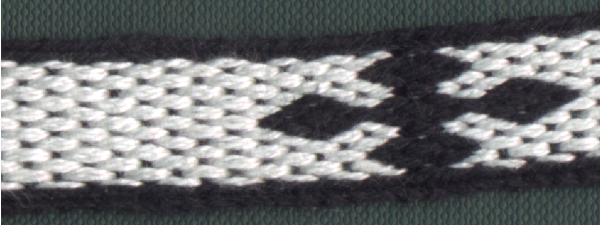Two-Hole Tablet Weaving
While four-hole tablet weaving is by far the most common modern form, and most common in the SCA, two-hole tablet weaving is frequently found in medieval and earlier contexts. Rather than restricting the range of structural and pattern possibilities, threading only two instead of four holes per tablet increases the available variety. It is possible to weave structures only possible with tablets, and structures indistinguishable from the products of other band-weaving methods, or both together! This complexity makes it difficult to conclusively identify tablet weaving unless it has the characteristic warp-twined borders. All of the finds discussed below had one or more selvage tablets threaded with four warps and turned consistently in one direction. Because of the wide range of structures seen in the early finds, it is possible that other bands were woven with tablets, but were not identified as such because of the lack of warp-twined selvedges. In my experience, a worker familiar with working with tablets can produce simple structures faster than way than using the conventional methods.
If the tablet is threaded through two adjacent holes, all possible sheds can be produced (both up, both down, one up and one down), making it possible to weave any structure possible with a four-harness loom! One interesting band from Laceby, England (6th century) was woven in a warp-faced tabby structure with a two-color design on the front face, and long floats on the back (Crowfoot 1956).
Here’s my attempt at reconstructing that band, based loosely on Collingwood’s interpretation. As you can see from the back of the band, it’s a very unusual structure for tablet weaving.
Front:

Back:

When diagonal holes are threaded instead of adjacent holes, only complementary structures can be woven. In these weaves, threads are paired, and when one appears on the face of the band, the other thread is on the back. These are the structures covered in this class.
Technical considerations Most tablet-weaving looms aren’t really suitable for two-hole weaves. The uneven tension on the tablets, whether they are threaded thru adjacent or diagonal holes, tends to pull them out of position. In an extreme case, I’ve had the entire pack reorient itself on the diagonal when I wasn’t paying attention. The best solution is to support the tablets by resting them on something.
I have a loom designed specifically for these weaves, so that the tablets are always supported. (It works well for any tablet weaving.) This loom is a 3-foot piece of oak (for sturdiness). Paired holes were drilled at both ends to attach hardwood crosspieces made from a 2x2. This is the right height to keep my tablets close enough to the base that they won’t turn on their own, but far enough that I can rotate them easily. There are several sets of holes at one end so the length between the crosspieces can be adjusted. The cloth end wraps around one crosspiece, and is held firmly when the nuts holding the crosspiece down are tightened. The warp is pulled tight and fastened under the other crosspiece. It is impossible to get high tension using this loom design.


When weaving with four-hole tablets, the determinants of structure are threading direction (S or Z) and turning sequence (F and/or B). (Color threading sequence, which color is in which hole, is a determinant of pattern but not structure.) Two-hole weaves have an additional concern – the initial placement of the empty holes.
Plain weave Inkle-type warp-faced plain weave can easily be done with tablets. The easiest way is to align all tablets with a thread in the far top hole. Turn the pack ¼ turn forward, pass the weft, then turn the pack ¼ turn back to bring the original thread back to the top. Hald (1930) hypothesized that warp-faced bands without 4-hole edges were woven on tablets.
Warp twining The simplest specifically tablet-woven structure is warp twining. Bands often have the threaded holes staggered, which produces a tight fabric. A band in this structure was found in Bramble Bottom, England (second half of the 13th century; Crowfoot 1954). This band had blocks of S and Z threading. More elaborate warp-twined bands with raised patterning are known from Viking Age Gotland (Nockert and Knudsen 1996).
Pattern weave from Hochdorf An elaborate two-hole weave is known from bands found in the Celtic chieftain burial at Hochdorf (Knudsen 1994, Banck-Burgess 1999). There is a band in the same technique from Chelles, France (van Epen 1997). This technique has been called “pebble weave”, but since that conflicts with the structurally different Andean pebble weave, I’m going to call it the Hochdorf structure until I come up with a better term. (And by the way, the Andean pebble weave can be woven on two-hole tablets too, although it was not done that way.)
Tablets are threaded with one light and one dark thread in opposite corners. While there are several ways of producing this structure, I’m going to stick to the simplest to explain, which requires all tablets to be S-threaded. Tablets are initially arranged so that the position of the light and dark threads circles the tablet (as for diagonal lines).
Tablets are turned FFBB, the same as for doubleface and twill. Tablets are always manipulated in pairs, which simplifies drawing the pattern drafts. To change color, turn tablets four times in the same direction.
Both doubleface and 3/1 twill done with four-hole tablets produce a 3/1 structure. Only the long floats appear on the surface; the shorter floats are hidden in the middle of the band. With only two threads per tablet, the “ones” also appear on the face of the band, creating the “pebbled” appearance.
Other structures There are many other structures possible with two-hole tablets. I’m still researching archaeological material and exploring the theoretical possibilities. Reinterpretation of the literature is always possible – bands from Mammen and Daetgen originally believed to be woven with two-hole tablets are now thought to have had two vegetable warp threads that were not preserved (Hansen 1990). If no warp-twined selvedges were used, it may not be possible to definitively identify a band as being woven with tablets. This has turned into a more challenging and complex project than I had originally anticipated, and I am enjoying it thoroughly!
Illustrated comparison of “pebble weave” and “Hochdorf weave”
The first example is the Andean pebble weave structure woven on 2-hole tablets wwith a 4-hole warp-twined selvedge. This structure is found in other regions, including Central Asia, but is traditionally not woven on tablets. There is no warp twining, and the front and back are identical but with reversed colors.
Front:

Back:

The second piece was woven in the Hochdorf structure. While the two look superficially similar in the ground weave, the patterning is structurally distinct. This structure has warp-twining at the color changes, and the front and the back look different.
Front:

Back:

Here’s the complete band (in two segments):


References
-
Banck-Burgess, Johanna. 1999. Hochdorf IV: Die Textilfunde. Konrad Theiss, Stuttgart, Germany.
Beautifully preserved textiles from Hochdorf, including several bands in two-hole weave. -
Crowfoot, G.M. 1954. Tablet-woven braid from a thirteenth-century site. Antiquaries Journal 34:234-235.
Warp-twining with two-hole tablets. -
Crowfoot, G.M. 1956. The textiles and impressions [from F.H. Thompson, Anglo-Saxon sites in Lincolnshire]. Antiquaries Journal 36:188-189.
Non-complementary two-hole weave: warp-faced plain weave on the front, long floats on the back. -
Hald, Margrethe. 1930. Brikvaevning i Danske oldtidsfund. 1930. Aarboger for Nordisk Oldkyndighed og Historie 20:276-301.
-
Hansen, Egon H. 1990. Tablet weaving: History, techniques, colours, patterns. Hovedland Publishers, Hobjerg, Denmark.
-
Knudsen, Lise Raeder. 1994. Analysis and reconstruction of two tabletwoven bands from the celtic burial hochdorf. NESAT V pp. 53-60 in: Jaacks, G. and Tidow, K. Northern European Symposium on Archaeological Textiles Volume 5 (NESAT V). Textilmuseum Neumuster.
One of these bands is in the two-hole Hochdorf structure. -
Nockert, Margareta and Lise Raeder Knudsen. 1996. Gotlandska brickband fran vikingatiden. Gotlandskt Arkiv 68:41-46.
Two-hole portion with staggered threading. Patterns warp twining with raised areas. (I think - I’m not done translating yet.) -
van Epen, Marijke. 1997. Tablet weaving - two threads per tablet. TWIST 4(3):8.
Describes a band from Chelles, France (7-8th century) woven with 2-holes per tablet in the Hochdorf structure. -
van Epen, Marijke. 1998. Tablet weaving with two threads per tablet - Part II. TWIST 5(2):4.
Weaving instructions for Hochdorf structure.
